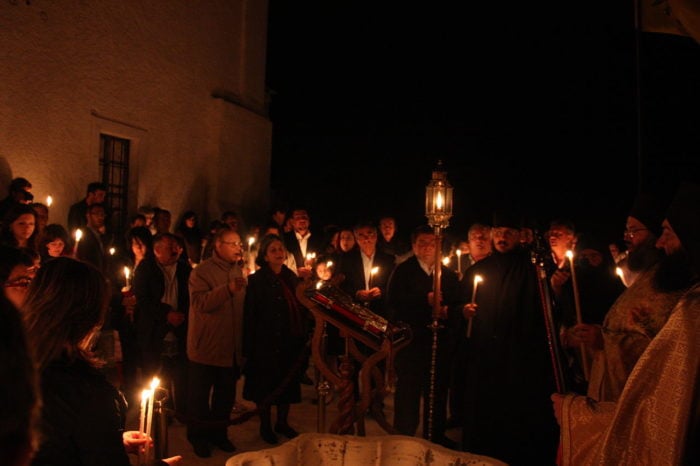
Greek Easter is the most revered time of the year for religious Greeks as they fast for forty days, go to confession, and attend long church liturgies.
On Holy Week, liturgies intensify and run for hours and hours. Also called Passion Week, the gospels read in church tell of the Passion of Christ, the painful days that led Him to the Cross and then to Resurrection.
Greek Easter Liturgies
Holy Monday begins the Greek Easter Holy Week with a liturgy commemorating the blessed and noble Joseph and the fig tree which was cursed and withered by the Lord.
The evening liturgy begins with the Hymn of the Bridegroom: “Behold the Bridegroom comes in the midst of the night…beware, therefore, O my soul, lest thou be borne down in sleep…and lest thou be shut out from the Kingdom…”
The Tuesday of Holy Week liturgy commemorates the parable of the Ten Virgins. It is about ethical preparation and wakefulness. It is at this time that the protopsaltis, or cantor, along with the choir, chants the centuries-old Troparion of Kassiane, a hauntingly lovely song written by Kassiane, a Byzantine nun.
The Hymn of Kassiane, sung every Tuesday of Holy Week around the world, is one of the many hymns composed by one of the few women known to have been writing music during Byzantine times.
Born in 805/810 and passing away before 865, Kassiane was a Byzantine abbess, poet, composer, and hymnographer.
Her hymn, called the Doxastikon on the Aposticha of the Bridegroom for Orthros, but better known as the Hymn of the Sinful Woman, is sung every Tuesday evening during Holy Week as the apex of the service on that day.
On Holy Wednesday, there is The Liturgy of the Presanctified Gifts. This very ancient Liturgy is a Vespers service.
In the evening, the sacred ceremony of the Mysterion of the Holy Unction takes place. It is the evening of repentance, confession, and the remission of sins by the Lord, preparing the faithful to receive Holy Communion, usually the next day.
Holy Thursday liturgies are the most heartbreaking of Greek Easter as Jesus Christ is betrayed and is led to his death at the end of the day. It is the day of the Last Supper, when He celebrated Passover with His disciples.
On Holy Thursday morning, the liturgy celebrates four Events: the washing of the disciples’ feet, the institution of the Holy Eucharist, the Marvelous Prayer, and the betrayal.
After the washing of His Apostles’ feet, Christ pointed out Judas the betrayer, inaugurated the Eucharist, and pronounced the new commandment of love for one another.
Upon leaving His Apostles, Christ spoke to them about the descent of the Holy Spirit to complete man’s union with Christ. The descent of the Holy Spirit, Christ said, would bring joy and peace to them and the world.
Holy Friday: a day of mourning
The Holy Friday liturgy is mourning for the painful Passion of Christ. To take away our sins, Christ willingly endured all kinds of torture, and finally the Cross and Death, purging all our sins with His death.
The liturgy also includes the reading of the “Twelve Gospels”.
On Holy Friday, church bells throughout Greece ring mournfully all day long and in the evening there is the Procession of the Epitaphios – representing the coffin of Christ – in each parish.
In the morning, the Epitaphios is decorated with spring flowers — mostly white, red, and purple — until it is entirely covered.
The Epitaphios is often sprinkled with flower petals and rosewater, decorated with candles and ceremonially censed as a mark of respect. Traditionally, the faithful walk underneath it as a gesture of faith.
In the evening, the ceremonial Epitaphios Procession takes place, led by the parish priests and followed by the faithful holding lit beeswax candles.
On Holy Saturday, psalms are read and Resurrection hymns are sung, telling of Christ’s descent into Hades: “Today Hades cried out groaning,” the psalm says.
The hymns speak of the conquering of death and the day’s celebration is called “First Resurrection.” Most of the readings of this day are from the Old Testament on the prophecies and promise of the conquering of death.
Christos Anesti!
Finally, at midnight, there is the moment that all Greeks around the world eagerly anticipate: The Resurrection ceremony with the joyous proclamation of “Christos Anesti!” (Christ is risen!).
On this glorious Greek Easter night, people wear their Sunday best, take a white candle, the lampatha (λαμπάδα), and go to church to attend the liturgy, waiting for midnight.
At midnight, all the priests come out and chant “Christos Anesti!” while they pass the Holy Light from which all the faithful light their candles and pass the light saying “Christos Anesti!” with the recipient replying”Alithos Anesti!” (Truly, He is risen!”
It is a night of joy after forty days of mourning as Orthodox Christians honor the Son of God who died for our sins and was then resurrected from the dead to show us the path of eternal life in faith.
See all the latest news from Greece and the world at Greekreporter.com. Contact our newsroom to report an update or send your story, photos and videos. Follow GR on Google News and subscribe here to our daily email!



